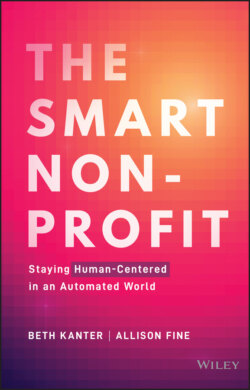Читать книгу The Smart Nonprofit - Beth Kanter - Страница 11
UNDERSTANDING SMART TECH
ОглавлениеWe use “smart tech” as an umbrella term for advanced digital technologies that make decisions for people, instead of people. It includes artificial intelligence (AI) and its subsets and cousins such as machine learning, natural language processing, smart forms, chatbots, robots, and drones. We want to be expansive in our use and understanding of the term, for instance, by including automation technologies like the one that powered the VI-SPDAT, in order to focus on the essence of the shift in power from people to machines. We substitute the word “bot” for smart tech in many sentences in this book because, well, it's fun to say.
Smart tech is not the same as digitizing a process. For instance, direct depositing a paycheck replaces printing a check and mailing it or handing it to an employee who has to endorse it and physically deposit it in the bank. Direct deposit is efficient, but it's not automation. Automation takes the power of decision-making and turns it over to machines. Automation turns a regular car into a smart car, and an active, decision-making driver into a passenger.
Netflix is powered by smart tech. They use our individual and collective viewing to make suggestions of what you may want to watch next. The more we all watch, the more accurate are Netflix's predictions. However, there is one enormous catch: the algorithms assume we want to continue watching the kinds of shows and movies we have in the past, that our future behavior will mimic past behavior. However, this isn't actually the way most people operate. We like to explore new things, bump into new people, and allow serendipity to take its course. This difference between the way machines think and the way people behave is a theme we will explore many times throughout this book.
Smart tech has some similarities with social media but more importantly, a few fundamental differences. Both are powered by digital technology, computer code, and enormous amounts of data. They also use the data and algorithms to predict future behavior. For instance, Facebook shows you ads based on what you have liked and shared previously. The more accurate Facebook's predictions, the more likely you are to click on an ad, which is how they make their money. However, we can see how Facebook operates or at least the results of Facebook's calculations. Even if Facebook doesn't want to put much work into controlling hate speech on its platform, we can see it unfolding on the platform. And if you can find the button to click to show you the most recent feeds, you can see which posts you've missed because Facebook decided to show you something else.
While social media is visible, smart tech is invisible like air. It doesn't care if you're rich or poor, at home in your kitchen, in the park, or at the office; it is everywhere around us working all the time. It is quickly becoming embedded in organizational life and making critical decisions such as who gets services, when and how, and how staff are performing their jobs. Perhaps the biggest difference between social media and smart tech is that the former creates an enormous amount of work while the latter, if used well, can create an enormous amount of time. And that time can be used to reduce burnout of staff; increase time spent with clients, volunteers, and donors; and imagine new ways to solve difficult problems.
Smart tech is best at doing rote tasks such as filling out intake forms and answering the same questions from people (for example, “Is my contribution tax-deductible?”) over and over. However, the technology is quickly moving beyond paperwork and embedding itself into the heart of nonprofit work. This is profoundly changing what we do, why we do it, and how successful we are in meeting our missions.
Nonprofits are beginning to use smart tech to:
Screen resumes based on criteria organizations set but without those organizations likely seeing the people who were screened out.
Determine eligibility for a host of social services such as SNAP food assistance, housing, and childcare.
Identify prospective donors from your fundraising data or from the web.
Customize stories for and communications to donors based on their past behavior.
Stock food pantry shelves.
Deliver medicine and food to hard-to-reach places.
Direct refugees to available beds.
This isn't science fiction; it is real life, right now.
Automating systems isn't a technological evolution; it is a revolutionary shift in power and autonomy. Those who understand the new technology and how to use it will have more power. Those who are reporting to tech systems and are at the mercy of them are at the risk of losing their ability to determine their own futures.
Smart nonprofits understand the technology—what it can and cannot do, how to use it well, and how to avoid unintentional harmful consequences.
